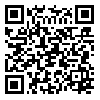Volume 80, Issue 1 (April 2022)
Tehran Univ Med J 2022, 80(1): 32-39 |
Back to browse issues page
Download citation:
BibTeX | RIS | EndNote | Medlars | ProCite | Reference Manager | RefWorks
Send citation to:



BibTeX | RIS | EndNote | Medlars | ProCite | Reference Manager | RefWorks
Send citation to:
Yarmahmoodi F, Jaafarzadeh Sarvestani F, Razavinejad S M, Zeinali Rafsanjani B. Assessment of the frequency of MRI findings in neonates under 6 months who referred to Shiraz hospitals with seizures. Tehran Univ Med J 2022; 80 (1) :32-39
URL: http://tumj.tums.ac.ir/article-1-11628-en.html
URL: http://tumj.tums.ac.ir/article-1-11628-en.html
Fatemeh Yarmahmoodi1 
 , Fatemeh Jaafarzadeh Sarvestani2
, Fatemeh Jaafarzadeh Sarvestani2 
 , Seyed Mostajab Razavinejad3
, Seyed Mostajab Razavinejad3 
 , Banafsheh Zeinali Rafsanjani *
, Banafsheh Zeinali Rafsanjani * 
 4
4

 , Fatemeh Jaafarzadeh Sarvestani2
, Fatemeh Jaafarzadeh Sarvestani2 
 , Seyed Mostajab Razavinejad3
, Seyed Mostajab Razavinejad3 
 , Banafsheh Zeinali Rafsanjani *
, Banafsheh Zeinali Rafsanjani * 
 4
4
1- Medical Imaging Research Center, Shiraz University of Medical Sciences, Shiraz, Iran. Department of Radiology, Shiraz University of Medical Sciences, Shiraz, Iran.
2- Department of Radiology, Shiraz University of Medical Sciences, Shiraz, Iran.
3- Neonatal Research Center, Shiraz University of Medical Sciences, Shiraz, Iran.
4- Medical Imaging Research Center, Shiraz University of Medical Sciences, Shiraz, Iran. ,b.zeinali.r@gmail.com
2- Department of Radiology, Shiraz University of Medical Sciences, Shiraz, Iran.
3- Neonatal Research Center, Shiraz University of Medical Sciences, Shiraz, Iran.
4- Medical Imaging Research Center, Shiraz University of Medical Sciences, Shiraz, Iran. ,
Abstract: (1508 Views)
Background: Neonatal seizures can have many causes. Determining the underlying cause of neonatal seizures is very important in determining the prognosis, outcome, and treatment strategies. In this study, we have evaluated the frequency of Magnetic resonance imaging (MRI) findings in neonates younger than 6 months who had been referred to Shiraz Namazi hospital with seizures to determine the prevalence of various causes of seizures.
Methods: This was a retrospective study, that was performed on 199 neonates younger than 6 months of age who were hospitalized due to seizures in hospitals affiliated with Shiraz medical sciences from 21st March 2018 to 20 March 2019. Patient data were extracted by statistics and health information system and imaging data and its reports were extracted from picture archiving and communication system. The data were statistically analyzed by SPSS V26.
Results: In this study, 199 infants under the age of 6 months were examined, of which 124 (62.3%) were boys and 75 (37.7%) were girls. 97 infants (48.7%) were less than one month old and 102 ones (81.3%) were in the age group of 1-6 months. It should be noted that in terms of gender, 57.3% (71) of male infants and 49.3% (37) of female infants had abnormal MRI findings. 54.3% of patients had abnormal MRI findings and 45.7% had normal MRI. The most common abnormal finding was hypoxic-ischemic encephalopathy (HIE), which was the most common cause of seizures in 21.1% of neonates, followed by infection with 12.5% and cerebral hemorrhage with 11% of prevalence. Other important abnormal findings included hydrocephalus, structural abnormalities, venous sinus thrombosis, brain atrophy, developmental abnormality, etc. There was a combination of radiological findings in 18.56% of neonates.
Methods: This was a retrospective study, that was performed on 199 neonates younger than 6 months of age who were hospitalized due to seizures in hospitals affiliated with Shiraz medical sciences from 21st March 2018 to 20 March 2019. Patient data were extracted by statistics and health information system and imaging data and its reports were extracted from picture archiving and communication system. The data were statistically analyzed by SPSS V26.
Results: In this study, 199 infants under the age of 6 months were examined, of which 124 (62.3%) were boys and 75 (37.7%) were girls. 97 infants (48.7%) were less than one month old and 102 ones (81.3%) were in the age group of 1-6 months. It should be noted that in terms of gender, 57.3% (71) of male infants and 49.3% (37) of female infants had abnormal MRI findings. 54.3% of patients had abnormal MRI findings and 45.7% had normal MRI. The most common abnormal finding was hypoxic-ischemic encephalopathy (HIE), which was the most common cause of seizures in 21.1% of neonates, followed by infection with 12.5% and cerebral hemorrhage with 11% of prevalence. Other important abnormal findings included hydrocephalus, structural abnormalities, venous sinus thrombosis, brain atrophy, developmental abnormality, etc. There was a combination of radiological findings in 18.56% of neonates.
|
Conclusion: This study showed that hypoxic-ischemic encephalopathy is the most common cause of neonatal seizures. Considering that in this study, a significant percentage (54.3%) of the neonates had abnormal brain MRI, this finding indicates the importance of performing this radiological procedure in the diagnosis, prognosis, and duration of treatment in neonatal seizures.
|
Type of Study: Original Article |
Send email to the article author
| Rights and permissions | |
 |
This work is licensed under a Creative Commons Attribution-NonCommercial 4.0 International License. |



